Bilabial
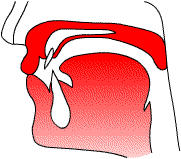 In a bilabial consonant, the lower and upper lips approach
or touch each other. English [p], [b], and [m] are
bilabial stops.
In a bilabial consonant, the lower and upper lips approach
or touch each other. English [p], [b], and [m] are
bilabial stops.
The diagram to the right shows the state of the vocal tract during a typical [p] or [b]. (An [m] would look the same, but with the velum lowered to let out through the nasal passages.)
Labiodental
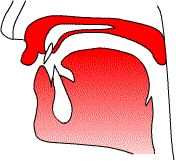 In a labiodental consonant, the lower lip approaches or
touches the upper teeth. English [f] and [v] are bilabial
fricatives.
In a labiodental consonant, the lower lip approaches or
touches the upper teeth. English [f] and [v] are bilabial
fricatives.
The diagram to the right shows the state of the vocal tract during a typical [f] or [v].
Labio-velar
The sound [w] involves two constrictions of the vocal tract made simultaneously. One of them is lip rounding, which you can think of as a bilabial approximant.
Dental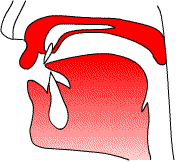
In a dental consonant, the tip or blade of the tongue approaches or touches the upper teeth. English [θ] and [ð] are dental fricatives. There are actually a couple of different ways of forming these sounds:
- The tongue tip can approach the back of the upper teeth, but not press against them so hard that the airflow is completely blocked.
- The blade of the tongue can touch the bottom of the upper teeth, with the tongue tip protruding between the teeth -- still leaving enough space for a turbulent airstream to escape. This kind of [θ] and [ð] is often called interdental.
Alveolar
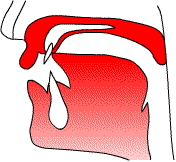 In an alveolar consonant, the tongue tip (or less often
the tongue blade) approaches or touches the alveolar ridge,
the ridge immediately behind the upper teeth. The English
stops [t], [d], and [n] are formed by completely blocking
the airflow at this place of articulation. The fricatives
[s] and [z] are also at this place of articulation, as is the
lateral approximant [l].
In an alveolar consonant, the tongue tip (or less often
the tongue blade) approaches or touches the alveolar ridge,
the ridge immediately behind the upper teeth. The English
stops [t], [d], and [n] are formed by completely blocking
the airflow at this place of articulation. The fricatives
[s] and [z] are also at this place of articulation, as is the
lateral approximant [l].
The diagram to the right shows the state of the vocal tract during plosive [t] or [d].
Plato-alveolar or Alveo-palatal
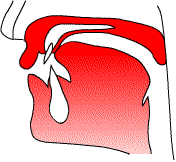 In a postalveolar consonant, the constriction is made
immediately behind the alveolar ridge. The constriction
can be made with either the tip or the blade of the tongue.
The English fricatives
[ʃ] and
[ʒ] are
made at this POA, as are the corresponding affricates
[tʃ] and
[dʒ].
In a postalveolar consonant, the constriction is made
immediately behind the alveolar ridge. The constriction
can be made with either the tip or the blade of the tongue.
The English fricatives
[ʃ] and
[ʒ] are
made at this POA, as are the corresponding affricates
[tʃ] and
[dʒ].
The diagram to the right shows the state of the vocal tract during the first half (the stop half) of an affricate [tʃ] or [dʒ].
Retroflex
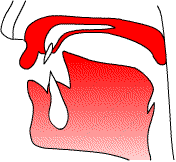 In a retroflex consonant, the tongue tip is curled backward in the mouth. English
[r] is a retroflex approximant -- the tongue tip is curled up toward the
postalveolar region (the area immediately behind the alveolar ridge).
In a retroflex consonant, the tongue tip is curled backward in the mouth. English
[r] is a retroflex approximant -- the tongue tip is curled up toward the
postalveolar region (the area immediately behind the alveolar ridge).
The diagram to the right shows a typical English retroflex [r].
Both the sounds we've called "postalveolar" and the sounds we've called "retroflex" involve the region behind the alveolar ridge. In fact, at least for English, you can think of retroflexes as being a sub-type of postalveolars, specifically, the type of postalveolars that you make by curling your tongue tip backward.
(In fact, the retroflexes and other postalveolars sound so similar that you can usually use either one in English without any noticeable effect on your accent. A substantial minority North American English speakers don't use a retroflex [r], but rather a "bunched" R -- sort of like a tongue-blade [ʒ] with an even wider opening. Similarly, a few people use a curled-up tongue tip rather than their tongue blades in making [ʃ] and [ʒ].)
Palatal
In a palatal consonant, the body of the tongue approaches or touches the hard palate. English [j] is a palatal approximant -- the tongue body approaches the hard palate, but closely enough to create turbulence in the airstream.Velar
 In a velar consonant, the body of the tongue approaches or
touches the soft palate, or velum. English [k],
[ɡ], and [ŋ] are stops
made at this POA. The [x] sound made at the end of the
German name Bach or the Scottish word loch
is the voiceless fricative made at the velar POA.
In a velar consonant, the body of the tongue approaches or
touches the soft palate, or velum. English [k],
[ɡ], and [ŋ] are stops
made at this POA. The [x] sound made at the end of the
German name Bach or the Scottish word loch
is the voiceless fricative made at the velar POA.
The diagram to the right shows a typical [k] or [ɡ] -- though where exactly on the velum the tongue body hits will vary a lot depending on the surrounding vowels.
As we have seen, one of the two constrictions that form a [w] is a bilabial approximant. The other is a velar approximant: the tongue body approaches the soft palate, but does not get even as close as it does in an [x].
No hay comentarios:
Publicar un comentario